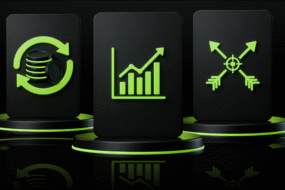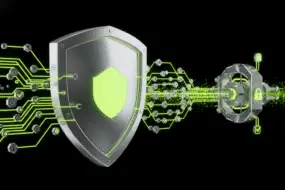
Blockchain technology has caught many by surprise in recent years. Generally associated with cryptocurrencies like Bitcoin and Ethereum, blockchain technology is a lot more than what meets the eye. It has emerged as a revolutionary force in various sectors by offering a decentralized digital ledger that records transactions across multiple computers. This ensures that the recorded data cannot be altered retroactively, without changing all subsequent blocks and the consensus of the network.
In this article, we will educate you about all the features and benefits besides clearing various misunderstandings about blockchain 101.

What are the Basics of Blockchain?
At its simplest, blockchain is a distributed database that allows for secure, transparent, and tamper-proof transactions. When a transaction occurs, it is grouped together in a cryptographically protected block with other transactions that have occurred in the same time frame.
How Exactly Does Blockchain Work?
Blockchain operates on the principles of decentralization, transparency, and immutability:
Decentralization
Decentralization is a foundational aspect of blockchain technology, which sets it apart from traditional database systems that are typically managed by central authorities such as a company’s IT department or financial institutions like banks.
In a decentralized blockchain system, the database, or ledger, is spread across a network of multiple nodes, which are essentially computers or servers participating in the blockchain. Each of these nodes holds a copy of the entire ledger, and all copies are updated simultaneously through a consensus process. This process involves nodes agreeing on the validity of transactions before they are permanently recorded on the blockchain.
Transparency
Transparency in blockchain technology means that every transaction made on the blockchain is open for anyone participating in that blockchain network to see. Once a transaction is added to the blockchain, it becomes a part of the public ledger, which is just a fancy way of saying a complete list or record of every transaction ever made on that blockchain.
Immutability
Immutability in the context of blockchain technology means that once data (like a transaction) has been recorded on the blockchain, it cannot be changed or deleted. This is a key feature that makes blockchain highly secure and trustworthy.
When you make a transaction on a blockchain, such as sending cryptocurrency to someone else, this transaction is recorded in a “block” of data. Each block is securely linked to the one before it using complex mathematical algorithms. This link is a kind of cryptographic seal or signature that is unique to each block.
Once a block is added to the blockchain, it becomes a permanent part of the record. The cryptographic links between blocks mean that if someone tries to go back and change a transaction in a previous block, they would have to change every single block that came after it as well, which is practically impossible due to the amount of computing power required. The immutability of blockchain helps prevent fraud and tampering. Since no one can change a transaction after it’s been recorded, you can trust that the transaction history on the blockchain is accurate and unaltered.

Key Features of Blockchain Technology
Distributed Ledger Technology (DLT)
All network participants have access to the distributed ledger and its immutable record of transactions.
Cryptographic Security
Complex cryptography ensures the security of the transactions.
Consensus Algorithms
These algorithms are critical for verifying the transactions. Popular consensus mechanisms include Proof of Work (PoW) and Proof of Stake (PoS).
Types of Blockchains
Public Blockchains
Public blockchains are types of digital ledgers that anyone can join and participate in without needing permission. They are open to the public, meaning you don’t have to be invited or approved by anyone to become part of the network.
Here’s a straightforward way to understand public blockchains:
Open Access
Just like the internet, where anyone can go online and access web pages, in public blockchains, anyone can join the network. You can view transactions, create new transactions, or even participate in the process that confirms these transactions, known as mining, depending on the blockchain.
Participation in Core Activities
In a public blockchain, you can be more than just a passive observer. You can actively engage in the blockchain’s core functions like verifying and recording transactions. This is done through a process that typically involves solving complex mathematical problems to ensure transactions are legitimate, a process known as mining in cryptocurrencies like Bitcoin.
Decentralization
Since there is no central authority controlling a public blockchain, it is maintained by numerous participants across the world. This dispersal of control makes it more secure and less likely to be manipulated by any single entity.
Transparency
Because it’s open to everyone, all the transactions recorded on a public blockchain are visible to anyone who wishes to see them. This transparency helps build trust among users and makes it very difficult to cheat the system.
Private Blockchains
Private blockchains are a type of digital ledger similar to public blockchains, but with restricted access. Only certain people or organizations are allowed to join and participate in the network.
Here’s how private blockchains work and why they are used:
Restricted Access
Unlike public blockchains that anyone can join, private blockchains require an invitation or permission to become part of the network. This means that only approved participants can view or enter transactions.
More Privacy
Because access is limited to a select group of people, private blockchains offer more privacy compared to their public counterparts. Transactions aren’t visible to the entire world, only to those who are part of the network.
Faster Transactions
With fewer participants involved in verifying and processing transactions, private blockchains can handle transactions faster than public blockchains. There’s less data to process per transaction, and since all participants are known and trusted, the transaction validation process can be simplified and sped up.
More Scalable
Private blockchains can be scaled more easily than public blockchains. Because they are controlled by fewer entities and have fewer nodes to manage, it’s easier to implement changes and manage larger volumes of transactions.

Consortium Blockchains
Consortium blockchains are a type of digital ledger that sits somewhere between private and public blockchains. They are controlled not by a single organization, but by a group of several companies or organizations.
Here’s a simple way to understand consortium blockchains:
Shared Control
Instead of one company having all the control (like in private blockchains) or having it completely open to the public (like in public blockchains), a consortium blockchain is managed by a pre-selected group of organizations. These organizations work together to make decisions about the blockchain’s rules, who can join, and how the data is accessed.
Purpose for Collaboration
Consortium blockchains are often set up for specific purposes where multiple organizations need to securely and efficiently share information without giving a single entity total control. This is common in industries like banking, supply chain, or healthcare where entities need to work together but also maintain independent control over their data.
Higher Efficiency and Trust
By allowing only a known group of participants to verify transactions, consortium blockchains can process transactions quickly and securely. Trust is higher because all participants are known and accountable to each other.
Privacy and Security
Like private blockchains, consortium blockchains offer more privacy and security than public ones because the access is restricted to a certain group. This setup helps protect sensitive data that companies might not want to expose on a public blockchain.
Applications of Blockchain Technology
Blockchain technology is incredibly versatile and is being used in many different fields beyond just cryptocurrencies. Here’s a simple breakdown of how blockchain is applied in various industries:
Finance
Blockchain can make financial transactions like sending money (payments), sending money back to your home country (remittances), and creating and enforcing contracts (complex contractual behavior) more transparent and efficient. It does this by cutting out middlemen like banks or payment processors, which means transactions can be faster and cheaper.

Supply Chain Management
In supply chains, blockchain helps track every step a product takes from where it is made to where it is sold. It ensures that all parties know where the product is at all times (traceability) and who is responsible at each step (accountability). This makes it easier to manage inventories and ensures that products are authentic and responsibly sourced.
Healthcare
Blockchain technology can greatly improve the way medical records are handled by making them more secure and private. It also allows for the secure sharing of these records between authorized individuals or institutions, such as doctors or hospitals. This can improve the speed and accuracy of medical treatments by ensuring that all medical professionals have access to the same, up-to-date information.
Real Estate
In real estate, blockchain can help reduce fraud and make transactions more efficient using smart contracts. These are automated contracts that execute certain actions (like transferring property titles) when conditions are met, reducing the need for lawyers or other intermediaries and speeding up transactions.
Voting
Blockchain can also transform voting systems, making them more secure and transparent. By using blockchain, votes can be recorded in a way that is almost impossible to tamper with. It also allows for the verification of election results by any observer, which can increase trust in the electoral process.
Advantages of Blockchain Technology
Blockchain technology offers several key advantages that make it a compelling choice for various applications across different industries. Here’s an easy-to-understand breakdown of some of these benefits:
Enhanced Security
Blockchain is much more secure than traditional record-keeping systems. It uses complex cryptography to secure the data, making it extremely difficult for hackers to manipulate. Each block of data is linked to the previous one, so any attempt to change information on one block would require changes across all subsequent blocks, which is practically impossible to do without being detected by other users on the network.
Reduced Costs
Blockchain can help save money by cutting out middlemen or intermediaries. In many traditional transactions, such as buying a house or sending international payments, there are several intermediaries like banks, lawyers, or brokers who facilitate the process but also add their fees. Blockchain allows parties to transact directly with each other, which eliminates the need for these intermediaries and therefore reduces the fees associated with their services.
Increased Efficiency and Speed
Blockchain can significantly speed up transactions and increase efficiency. Since it’s a decentralized system, it doesn’t require the time-consuming process of going through traditional banks or clearinghouses. Transactions can be completed faster and can be processed 24/7. Additionally, blockchain can automate various processes through smart contracts, which automatically perform certain actions when predetermined conditions are met. This automation reduces human error and the time typically needed to complete these tasks.
Challenges Facing Blockchain
Blockchain technology, despite its many benefits, faces several significant challenges that can affect its adoption and effectiveness. Here’s a straightforward explanation of these main issues:
Scalability
Scalability is a big challenge for blockchain, especially for the most well-known ones like Bitcoin and Ethereum. Essentially, as more and more transactions are made, the blockchain network can struggle to process them quickly because each transaction needs to be recorded on every single computer or node in the network. This can lead to slower transaction times and higher costs, making it less practical for widespread use, especially for systems that need to handle large volumes of transactions quickly.
Regulatory Issues
Blockchain technology often operates across international borders and can be used for a wide range of activities, from financial transactions to voting systems. This can make it difficult to regulate, as different countries have different rules about technology and financial operations. The decentralized nature of blockchain makes it hard to apply any single set of regulations, leading to complex legal and compliance issues.
Technology Integration
Integrating blockchain with existing technologies can also be a significant hurdle. Most traditional systems in businesses and governments are not set up to work with blockchain, and changing these systems to incorporate blockchain can be both technically challenging and costly. There’s also the need to ensure that all parts of a business or governmental organization can interact smoothly with the blockchain, requiring extensive updates or replacements of existing software and hardware.
The Future of Blockchain
Imagine a future where every transaction you make, whether buying a cup of coffee or trading stocks, is as transparent as glass and secure as a vault. This is the promise of blockchain technology, which is poised to revolutionize the way we conduct our daily activities and business operations.
Blockchain technology is a digital revolution in the making. As it matures and evolves, here’s how it could reshape our world:
More Secure Transactions
With blockchain, every transaction is encrypted and linked to the previous one, creating a chain that is nearly impossible to break. This could significantly reduce fraud and cyberattacks, making our digital interactions safer.
Transparent Operations
Imagine a world where you can trace the origin of your morning coffee back to the farmer who harvested the beans. Blockchain’s transparency allows for such traceability, providing consumers with greater confidence in the products they buy and use.
Efficiency Like Never Before
Blockchain can streamline processes across various industries—from how we vote, to how we manage healthcare records, to how we handle legal contracts. This could lead to faster, more efficient services, with less paperwork and lower costs.
Widespread Adoption Across Industries
As blockchain continues to overcome challenges like scalability and integration, more sectors will adopt this technology. From finance to farming, blockchain could become as commonplace as the internet, transforming how industries operate and deliver services.
Empowering Individuals
Blockchain gives power back to the people by eliminating middlemen in many processes, from banking to real estate transactions. This decentralization not only saves money but also speeds up transactions, empowering individuals to have more control over their own data and dealings.
Key Takeaways
As we look to the future, the journey of blockchain is one of innovation and integration. The technology’s potential to enhance security, transparency, and efficiency is immense. While there are hurdles to overcome, the progress made so far suggests a bright future where blockchain technology is woven into the fabric of our daily lives, reshaping industries and empowering individuals with greater control and confidence in their digital interactions.
Understanding blockchain is the first step toward recognizing its potential impacts and opportunities.
FAQs About Blockchain
What is the most common use of blockchain technology today?
Beyond cryptocurrencies, blockchain is commonly used for supply chain management, smart contracts, and securing personal identity data.
Can blockchain be hacked?
While blockchain itself is very secure, applications built on it can have vulnerabilities if not properly designed.
Is blockchain technology only useful for financial transactions?
No, blockchain can be applied in numerous fields, including healthcare, real estate, and even governance.
How does blockchain ensure data privacy?
While blockchain is transparent, it can be configured to keep certain information private through the use of permissions and private networks.
What are smart contracts in the context of blockchain?
Smart contracts are self-executing contracts with the terms directly written into code, which automatically enforce and execute the terms of the agreement based on blockchain.












